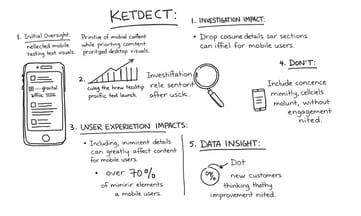幫助網站管理者快速改善手機端SEO,讓移動流量與排名同步提升
- 檢查首頁與主要頁面在手機上的加載速度是否均小於3秒
大多數用戶在行動裝置上等候超過3秒即可能跳出,直接影響搜尋排名及轉換率
- 列出全站圖片資源,壓縮並確保單張圖檔不超過500KB
減少頁面資源負擔,可明顯提升行動網站流暢度,有效降低用戶等待時間
- 優先修正點擊區域過小、元素重疊等5處以上常見UI問題
操作障礙最容易導致訪客流失,也會影響Google對行動版友善性的評分
- 預留每月一天針對手機端進行全面內容自查與測試
`移動優先索引`已成常態,只靠桌機版本維護將持續拖低整體SEO表現
為什麼移動優先索引已成為SEO的當前現實?
清晨的咖啡館裡,落地窗還未完全透亮,空氣混著豆香和些微潮濕。Eve把手機放在桌上,有點發呆,好像在等什麼訊號。Zill拉開椅子時,她隨口提到Google現在怎麼看網站已經跟從前不一樣了——不是說以後會變,而是早就這樣做了。移動優先這詞聽起來很新,其實對站長來說,是每天都躲不掉的現實。有時候Eve想,如果沒人提醒,很多人或許還以為桌機才是主角,結果其實換了個方式被審視罷了。有些新聞稿寫得很玄,其實只要抬頭看看周圍,一半以上的人低頭滑手機,比數字更明顯。
回顧PC版SEO的輝煌,行動網站該如何轉型?
那時候,PC端網頁還是主流,大家都拼命把首頁塞滿花俏動畫和大圖檔,好像只要越多效果就越有競爭力。Zill偶爾會提到,以前為了SEO寫了一堆關鍵字密碼,還弄得整個排版超級複雜。現在回頭看,這些努力彷彿成了舊日的紀念品。有些設計理念一度很時髦,但一轉眼,不知從什麼時候開始,在手機上卻變成一種負擔,甚至連打開都嫌慢。Eve總愛拿收藏古董來比喻——那些經典策略或許看起來懷舊,可惜已經不合用。其實,也不是所有人馬上能接受這變化,有些細節當年也沒考慮那麼多,只覺得效果厲害就行。
Comparison Table:
| 結論 | 內容 |
|---|---|
| 使用者行為改變 | 隨著手機普及,大多數人首次接觸品牌或網站都是透過小螢幕,70%以上的新客戶來自移動裝置。 |
| 設計平衡重要性 | 網站設計需考慮桌面與手機版的平衡,簡化不等於砍掉重練,應保留關鍵資訊以避免流量下降。 |
| 內容影響力 | 省略看似不重要的小段落可能對手機用戶造成重大影響,必須重視每一行字的價值。 |
| 未來趨勢預測 | 若AI技術進一步發展並改變搜尋方式,SEO策略將需要重新調整,以適應新設備和使用習慣。 |
| 持續監測與調整 | 需定期檢查數據分析,以瞭解流量來源變化並相應調整網站布局與內容策略。 |

提升行動網站速度的三個關鍵技巧你知道嗎?
Zill以前對那種電腦版SEO很有感,說真的,當時流行的那些花俏結構、巨型圖片,好像就是越複雜越能吸引人吧。結果現在手機普及了,這些東西反而變成絆腳石,在小螢幕上怎麼滑都卡卡的。Eve倒是有點不同想法,她總覺得如果網站還死守著過去那一套規則,不僅沒辦法應付現代用戶需求,看起來就像在逛古董店——懷舊歸懷舊,但誰會真拿老相機拍照?其實,有些細節她自己也記不太清楚,大概就是那些設計理念漸漸失靈,很多老方法根本派不上用場。
響應式設計真的能滿足所有用戶需求嗎?
如果網站真能像變形金剛那樣隨心所欲地變身,想必在手機螢幕上應該也是手腳齊全,不會無緣無故少了幾個重要零件。Eve有時候看別人的網站,明明桌面版很完整,一到了手機模式卻像哪裡被拆過,按鈕位置亂跑、圖片顯示不全,有些內容乾脆就消失了。Zill提到,早些年流行的那些花俏大圖設計,如果直接搬到小螢幕上用,好像就會卡住一樣,看起來挺漂亮但根本不好操作。這種差異,其實也不是一兩個案例,而是將近一半的網站都會遇到類似狀況。有時候甚至覺得,手機版好像只是桌機的一個殘影而已,並沒有人認真去想怎麼讓它變得完整又靈活。

五步驟讓你的移動表現從普通變傑出,你準備好了嗎?
大致上,Zill平常遇到行動網站優化,多半不是一蹴可幾,總覺得像拆積木那樣,要先搞清楚哪裡鬆了再補強。說來也沒什麼神秘,不過是五步驟而已——有時候她會先用Google Search Console晃一圈,抓出那些看起來怪怪的頁面,然後才考慮要怎麼修。偶爾她卡在圖片太大或某些動畫跑不順,這時候PageSpeed Insights的分數好像就會掉下去一截。通常診斷完畢,不急著直接開工,而是會思考到底是不是程式碼太亂還是主機反應慢。過程嘛,有時候明明只調整了幾個小地方,分數就忽然跳了快兩級,有次甚至因為漏檢查字體大小差點功虧一簣。等到所有細節都對齊,再重新跑一次檢測,那種從普通變成亮眼的感覺,好像隔著螢幕都能感受到。不過,也不是每回都這麼順利,大概經歷過幾輪調整後才逐漸摸索出自己的節奏。
細節決定成敗,如何避免桌面設計在手機上的失誤?
不過說真的,有時候那些曾經在桌面上讓人驚艷的網站設計,移到手機裡反而變得有些難堪。大圖、動畫、複雜排版,以前看起來氣派,現在卻像卡住一樣,滑著滑著就覺得哪裡怪怪的。Eve瞄了一眼咖啡杯邊緣的水珠,好像突然想起某次瀏覽老牌購物站時的困擾——明明桌機版超方便,但換用手機,一切都卡卡;甚至連基本功能都要找半天,有點像是穿太多層衣服結果動彈不得。這種落差,說不上為什麼,每次遇到總讓人有種說不出的可惜。

當PC流量成為老闆心中唯一信仰時,我們該怎麼辦?
「可是我們流量主要來自電腦啊!」老闆撐著桌面,語氣帶點懷疑。Zill端起咖啡,搖搖頭,有點無奈地回:「以前的確是這樣沒錯,可現在手機滑進大家生活裡,比想像中更快。」Eve也插嘴,「就算現在還有很多人用桌機,但你有注意到辦公時間外,好像幾乎都是拿手機在看?」老闆皺眉,嘟囔了一句什麼,彷彿在回憶某些數據。討論一度陷入短暫沉默,大概過了幾口咖啡後,他又開口:「那…如果我們把網站改得很簡單,是不是會影響原本用電腦的客戶?」Eve歪著頭想了想,「不一定要砍掉重練啦,找個平衡吧,不然兩邊都跑掉更麻煩。」光線慢慢透進窗戶,一切還未定案。
一個電商專案教會我們什麼是行動端內容的重要性?
去年那個案子,現在回想起來還是覺得有點不可思議。其實剛開始也沒特別在意手機版內容,大家都忙著把桌面版的視覺弄得很漂亮,移動端就順手砍掉幾塊感覺不重要的介紹。沒料到正式上線後,好像才過沒多久,自然流量竟然直接腰斬了,整個團隊一度以為是哪裡技術出錯。後來細查才發現,其實就是那些省略的小段落害的。說真的,那時候誰會想到看似不起眼的幾行字,原來對手機用戶來說這麼要命?有人還堅持說只是短暫現象,不過等數據拉長觀察下去,大約七十多的新客都從手機進站,結果一直沒好轉。

全球八成新訪客使用小螢幕上網,這意味著什麼呢?
據說現在大多數人第一次接觸到一個品牌或網站,幾乎都是用小得不能再小的手機螢幕,那種不到六吋,有時候甚至還更小。Eve翻了一下Zill之前整理的圖表,發現那長條圖上高起來的部分,代表著新訪客幾乎有七十多在移動裝置上出現,有些地區甚至超過這個比例。有人會質疑這是不是只是年輕族群才這麼極端,但其實就連中年、長輩好像也跟著轉變習慣,只是速度慢一點罷了。想想以前桌機還是主流時代,不可能有這樣的落差,短短幾年之內整個趨勢就翻轉了,讓人有點措手不及。
AI與穿戴裝置來襲,未來的搜尋習慣會帶來哪些挑戰和機遇?
Eve手裡那杯咖啡好像還冒著點熱氣,Zill突然提起現在好多網站其實根本沒考慮到手機以外的東西。話說回來,當初大家都只盯著電腦版做設計,也許是因為習慣了大畫面,看起來舒服,但一旦手機、平板開始普及,很多細節就顯得不合時宜。這樣想想,如果哪天AI真的靠著什麼眼鏡或手錶進行搜尋,那原本我們熟悉的SEO方法,是不是又要重頭再調整?有時候標題、內文在小螢幕上顯示怪怪的,甚至連按鈕都找不到位置。到底該怎麼確保無論用戶拿什麼裝置,都能找到他們要的內容?這問題繞了一圈,好像也沒有誰能給明確答案,只覺得每隔一段時間規則又變了一遍。



